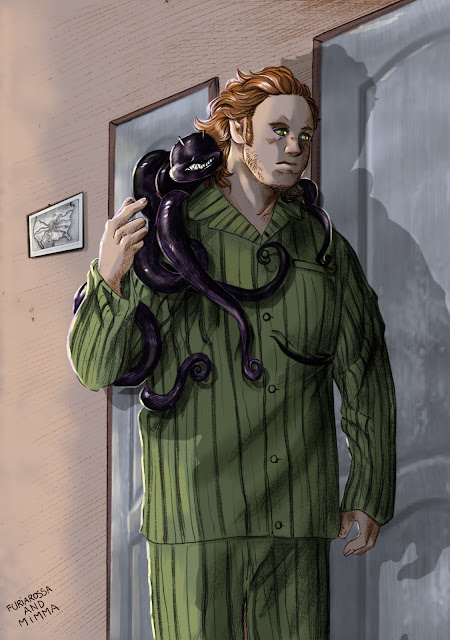Sock eaters (Nigris sublecto) are small to medium-sized spirits belonging to the Lemures group. They are synanthropic spirits, very common inside the homes of humans living in North America.
Etymology
The scientific name of this creature, Nigris sublecto, refers to their habit of hiding in dark and narrow places, such as under beds. The common name of the creature, sock eaters, refers to the fact that they often steal human socks to make a nest, consisting of a pile of soft objects (of which, of course, socks are the favorites) to hide under. Contrary to what was thought in older times, sock eaters do not feed on socks, nor any other article of clothing.
Appearance
Once they reach adulthood, sock eaters are between forty-five centimeters and two meters long. They have a long, tapered, serpentine body, and a halo of tentacles extending from their necks are more or less the length of their bodies, giving the impression that the creature is composed only of a small head and a tangle of long tentacles.
Their skin color is entirely black. Belonging to the Nigris family, scientists debate whether the tentacles are actually tails, like those that make up the fake tentacles of their smaller cousins, the wuppi, and so far research seems to point in that direction: not having a skeletal system, and their anatomy being extremely different from that of animals in the physical world, it is not implausible that the multiple tails have "climbed up" their body, over years of evolution, reaching the neck.
Sock eaters do not have visible eyes, these being always protected by a layer of skin, and are very short-sighted: basically they only use their eyes to detect light sources and the movement of large objects, from which they tend to run away. Their head, with very rounded contours, is slightly flattened and characterized by a wide mouth, full of sharp and triangular teeth. On the top of the head, two small semi-rigid antennae emerge, with which they can perceive changes in the electromagnetic field and communicate with each other.
Unlike most other lemurs of the Nigris family, sock eaters love to manifest themselves in the material world: they are in fact able to metabolize the life force, and later, when their bodies have fully materialized and adapted, the proteins they take from their small prey.
When a sock eater is fully materialized, it becomes very dense and heavy for its size, weighing up to forty-five kilos in exceptional cases. Behavior Sock eaters are solitary spirits, who hide in attics, old garages, rarely used bedrooms and sometimes in laundries or in the shaft of disused elevators. They are normally very shy, but it is possible for a human to domesticate them and even train them, due to their high intelligence. The mechanism is simple: guided only by their instinct, sock eaters will willingly accept small actions, to obey certain commands, in exchange for delicious morsels of food.
However, you must be very careful: even if a sock eater has become accustomed to the presence of a human, it does not mean that it will accept anyone in its territory, and if it is forced against its will to interact with other people it does not know, without having an escape route, it can attack and seriously injure even an adult human, thanks to its sharp teeth and the prodigious strength of its tentacles.
Reproduction always occurs in the spiritual world, as newborns are too weak to manifest themselves in the physical world; the young will migrate to their new home only once they have become capable of assuming pseudo-material forms.
Habitat
Wherever there are old closed rooms and insects that can be captured, there will be sock eaters. Contrary to what many so-called "paranormal hunters" believe, the main spirits that inhabit abandoned asylums are not those of the humans who died there, but sock eaters, who make their lairs under piles of garbage that they accumulate over years of residence.
Sock eaters love humid environments, full of decaying material, which attract many small animals, but they are happy with dry and clean rooms, if they can find other ways to get food.
Diet
As already mentioned, the diet of sock eaters consists mainly of small animals of the physical world. The younger specimens feed on ants, dipteran larvae and cockroaches, the older ones capture, thanks to their tentacles that they extend outside the nest like traps, rats and other occasional visitors to abandoned places. Domesticated sock eaters have generally more varied and balanced diet, resulting in better health.
Conservation
Sock Eaters are not currently in danger of extinction and will not be as long as places such as abandoned buildings or old attics exist.
Trivia
- In the past, some sock eaters have attacked and killed humans while they were sleeping, then slowly devoured them. It is not known what exactly triggered this anomalous behavior, but in any case nothing like this has happened since 1980, despite the fact that the number of sock eaters in the world has not decreased.
- No child has ever been killed by a sock eater.
- Many magic users voluntarily attract and host sock eaters in their homes, using them as a natural remedy for cockroach or rat infestations. A single adult sock eater can catch and eat up to seventy cockroaches in a day!


Nessun commento:
Posta un commento